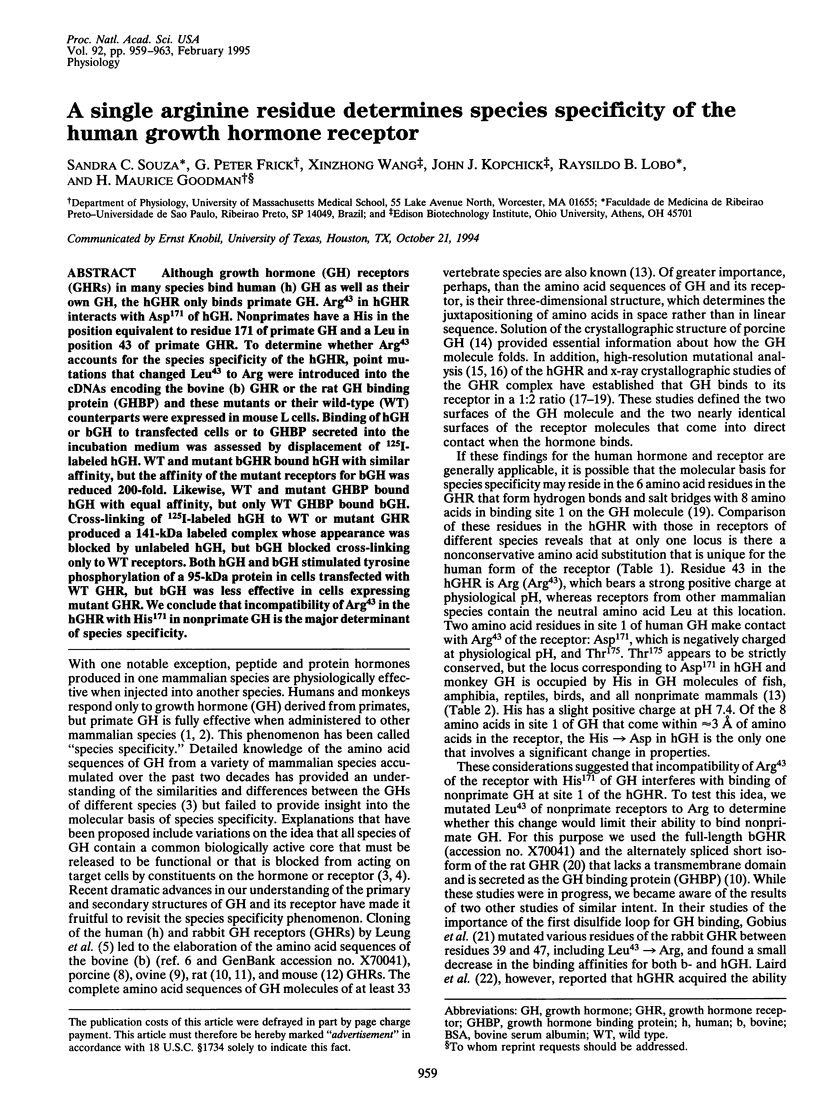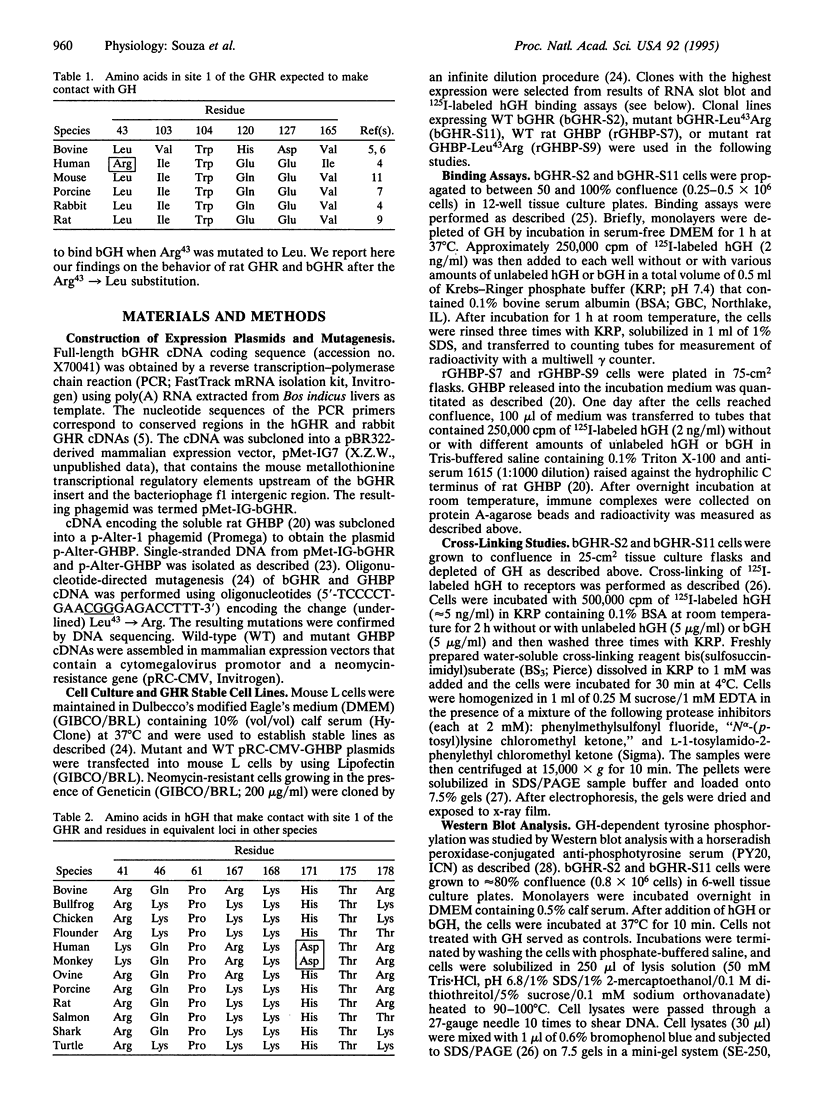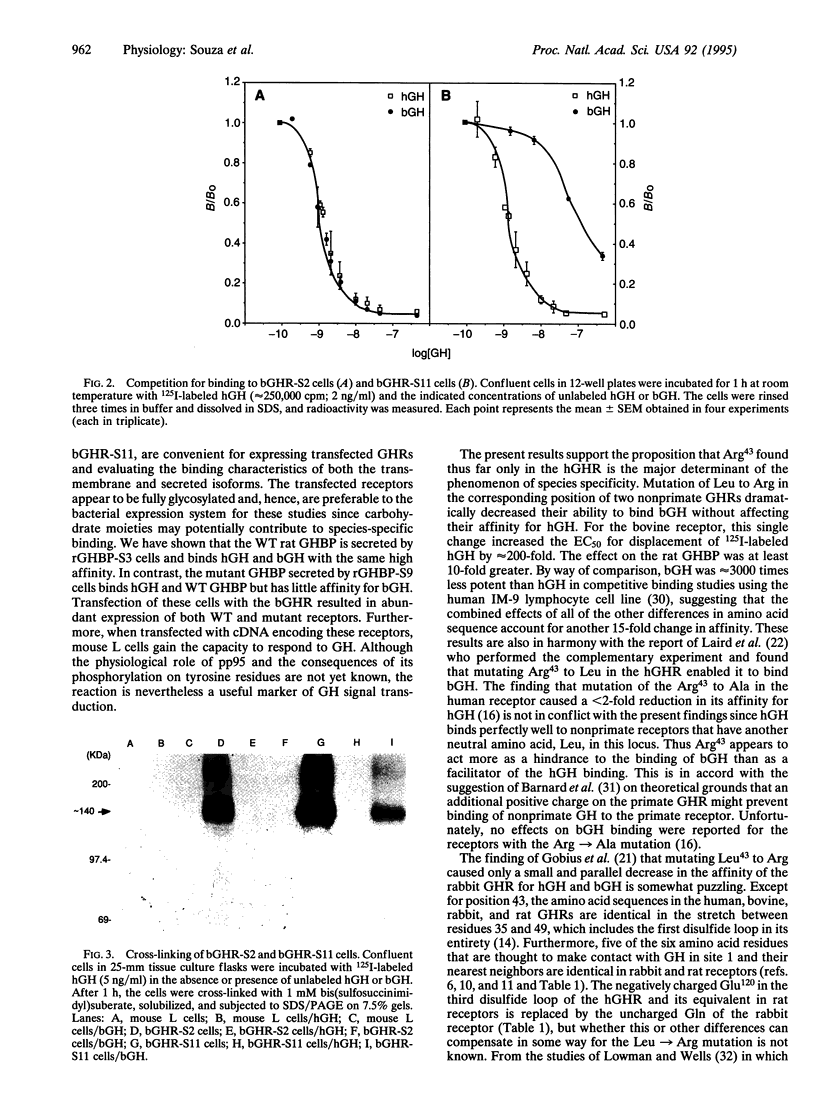Abstract
Although growth hormone (GH) receptors (GHRs) in many species bind human (h) GH as well as their own GH, the hGHR only binds primate GH. Arg43 in hGHR interacts with Asp171 of hGH. Nonprimates have a His in the position equivalent to residue 171 of primate GH and a Leu in position 43 of primate GHR. To determine whether Arg43 accounts for the species specificity of the hGHR, point mutations that changed Leu43 to Arg were introduced into the cDNAs encoding the bovine (b) GHR or the rat GH binding protein (GHBP) and these mutants or their wild-type (WT) counterparts were expressed in mouse L cells. Binding of hGH or bGH to transfected cells or to GHBP secreted into the incubation medium was assessed by displacement of 125I-labeled hGH. WT and mutant bGHR bound hGH with similar affinity, but the affinity of the mutant receptors for bGH was reduced 200-fold. Likewise, WT and mutant GHBP bound hGH with equal affinity, but only WT GHBP bound bGH. Cross-linking of 125I-labeled hGH to WT or mutant GHR produced a 141-kDa labeled complex whose appearance was blocked by unlabeled hGH, but bGH blocked cross-linking only to WT receptors. Both hGH and bGH stimulated tyrosine phosphorylation of a 95-kDa protein in cells transfected with WT GHR, but bGH was less effective in cells expressing mutant GHR. We conclude that incompatibility of Arg43 in the hGHR with His171 in nonprimate GH is the major determinant of species specificity.
Full text
PDF




Images in this article
Selected References
These references are in PubMed. This may not be the complete list of references from this article.
- Abdel-Meguid S. S., Shieh H. S., Smith W. W., Dayringer H. E., Violand B. N., Bentle L. A. Three-dimensional structure of a genetically engineered variant of porcine growth hormone. Proc Natl Acad Sci U S A. 1987 Sep;84(18):6434–6437. doi: 10.1073/pnas.84.18.6434. [DOI] [PMC free article] [PubMed] [Google Scholar]
- Adams T. E., Baker L., Fiddes R. J., Brandon M. R. The sheep growth hormone receptor: molecular cloning and ontogeny of mRNA expression in the liver. Mol Cell Endocrinol. 1990 Oct 22;73(2-3):135–145. doi: 10.1016/0303-7207(90)90126-s. [DOI] [PubMed] [Google Scholar]
- Barnard R., Rowlinson S. W., Waters M. J. An electrostatic model for the interaction between growth hormone and its receptor involving chelation of Ca2+ to the human growth hormone molecule. J Theor Biol. 1989 Oct 9;140(3):355–367. doi: 10.1016/s0022-5193(89)80092-x. [DOI] [PubMed] [Google Scholar]
- Bass S. H., Mulkerrin M. G., Wells J. A. A systematic mutational analysis of hormone-binding determinants in the human growth hormone receptor. Proc Natl Acad Sci U S A. 1991 May 15;88(10):4498–4502. doi: 10.1073/pnas.88.10.4498. [DOI] [PMC free article] [PubMed] [Google Scholar]
- Baumbach W. R., Horner D. L., Logan J. S. The growth hormone-binding protein in rat serum is an alternatively spliced form of the rat growth hormone receptor. Genes Dev. 1989 Aug;3(8):1199–1205. doi: 10.1101/gad.3.8.1199. [DOI] [PubMed] [Google Scholar]
- Carr D., Friesen H. G. Growth hormone and insulin binding to human liver. J Clin Endocrinol Metab. 1976 Mar;42(3):484–493. doi: 10.1210/jcem-42-3-484. [DOI] [PubMed] [Google Scholar]
- Cioffi J. A., Wang X., Kopchick J. J. Porcine growth hormone receptor cDNA sequence. Nucleic Acids Res. 1990 Nov 11;18(21):6451–6451. doi: 10.1093/nar/18.21.6451. [DOI] [PMC free article] [PubMed] [Google Scholar]
- Colosi P., Thordarson G., Hellmiss R., Singh K., Forsyth I. A., Gluckman P., Wood W. I. Cloning and expression of ovine placental lactogen. Mol Endocrinol. 1989 Sep;3(9):1462–1469. doi: 10.1210/mend-3-9-1462. [DOI] [PubMed] [Google Scholar]
- Cunningham B. C., Ultsch M., De Vos A. M., Mulkerrin M. G., Clauser K. R., Wells J. A. Dimerization of the extracellular domain of the human growth hormone receptor by a single hormone molecule. Science. 1991 Nov 8;254(5033):821–825. doi: 10.1126/science.1948064. [DOI] [PubMed] [Google Scholar]
- Cunningham B. C., Wells J. A. High-resolution epitope mapping of hGH-receptor interactions by alanine-scanning mutagenesis. Science. 1989 Jun 2;244(4908):1081–1085. doi: 10.1126/science.2471267. [DOI] [PubMed] [Google Scholar]
- Emtner M., Mathews L. S., Norstedt G. Growth hormone (GH) stimulates protein synthesis in cells transfected with GH receptor complementary DNA. Mol Endocrinol. 1990 Dec;4(12):2014–2020. doi: 10.1210/mend-4-12-2014. [DOI] [PubMed] [Google Scholar]
- Frick G. P., Goodman H. M. Characterization of the short isoform of the growth hormone receptor synthesized by rat adipocytes. Endocrinology. 1992 Dec;131(6):3083–3090. doi: 10.1210/endo.131.6.1446642. [DOI] [PubMed] [Google Scholar]
- Gobius K. S., Rowlinson S. W., Barnard R., Mattick J. S., Waters M. J. The first disulphide loop of the rabbit growth hormone receptor is required for binding to the hormone. J Mol Endocrinol. 1992 Dec;9(3):213–220. doi: 10.1677/jme.0.0090213. [DOI] [PubMed] [Google Scholar]
- Golos T. G., Durning M., Fisher J. M., Fowler P. D. Cloning of four growth hormone/chorionic somatomammotropin-related complementary deoxyribonucleic acids differentially expressed during pregnancy in the rhesus monkey placenta. Endocrinology. 1993 Oct;133(4):1744–1752. doi: 10.1210/endo.133.4.8404617. [DOI] [PubMed] [Google Scholar]
- Gorin E., Goodman H. M. Turnover of growth hormone receptors in rat adipocytes. Endocrinology. 1985 May;116(5):1796–1805. doi: 10.1210/endo-116-5-1796. [DOI] [PubMed] [Google Scholar]
- Hauser S. D., McGrath M. F., Collier R. J., Krivi G. G. Cloning and in vivo expression of bovine growth hormone receptor mRNA. Mol Cell Endocrinol. 1990 Sep 10;72(3):187–200. doi: 10.1016/0303-7207(90)90143-v. [DOI] [PubMed] [Google Scholar]
- Kostyo J. L., Wilhelmi A. F. Conference on the structure-function relationships of pituitary growth hormone: a report. Metabolism. 1976 Jan;25(1):105–124. doi: 10.1016/0026-0495(76)90165-7. [DOI] [PubMed] [Google Scholar]
- LI C. H. Properties of and structural investigations on growth hormones isolated from bovine, monkey and human pituitary glands. Fed Proc. 1957 Sep;16(3):775–783. [PubMed] [Google Scholar]
- Laemmli U. K. Cleavage of structural proteins during the assembly of the head of bacteriophage T4. Nature. 1970 Aug 15;227(5259):680–685. doi: 10.1038/227680a0. [DOI] [PubMed] [Google Scholar]
- Lesniak M. A., Gorden P., Roth J. Reactivity of non-primate growth hormones and prolactins with human growth hormone receptors on cultured human lymphocytes. J Clin Endocrinol Metab. 1977 May;44(5):838–849. doi: 10.1210/jcem-44-5-838. [DOI] [PubMed] [Google Scholar]
- Leung D. W., Spencer S. A., Cachianes G., Hammonds R. G., Collins C., Henzel W. J., Barnard R., Waters M. J., Wood W. I. Growth hormone receptor and serum binding protein: purification, cloning and expression. Nature. 1987 Dec 10;330(6148):537–543. doi: 10.1038/330537a0. [DOI] [PubMed] [Google Scholar]
- Lowman H. B., Wells J. A. Affinity maturation of human growth hormone by monovalent phage display. J Mol Biol. 1993 Dec 5;234(3):564–578. doi: 10.1006/jmbi.1993.1612. [DOI] [PubMed] [Google Scholar]
- Mathews L. S., Enberg B., Norstedt G. Regulation of rat growth hormone receptor gene expression. J Biol Chem. 1989 Jun 15;264(17):9905–9910. [PubMed] [Google Scholar]
- Nicoll C. S., Mayer G. L., Russell S. M. Structural features of prolactins and growth hormones that can be related to their biological properties. Endocr Rev. 1986 May;7(2):169–203. doi: 10.1210/edrv-7-2-169. [DOI] [PubMed] [Google Scholar]
- Smith W. C., Kuniyoshi J., Talamantes F. Mouse serum growth hormone (GH) binding protein has GH receptor extracellular and substituted transmembrane domains. Mol Endocrinol. 1989 Jun;3(6):984–990. doi: 10.1210/mend-3-6-984. [DOI] [PubMed] [Google Scholar]
- Ultsch M., de Vos A. M., Kossiakoff A. A. Crystals of the complex between human growth hormone and the extracellular domain of its receptor. J Mol Biol. 1991 Dec 20;222(4):865–868. doi: 10.1016/0022-2836(91)90578-t. [DOI] [PubMed] [Google Scholar]
- Wang X., Cioffi J. A., Kelder B., Harding P. A., Chen W. Y., Kopchick J. J. Expression of a functional porcine growth hormone receptor cDNA in mouse L cells. Mol Cell Endocrinol. 1993 Jul;94(1):89–96. doi: 10.1016/0303-7207(93)90055-o. [DOI] [PubMed] [Google Scholar]
- Wang X., Xu B., Souza S. C., Kopchick J. J. Growth hormone (GH) induces tyrosine-phosphorylated proteins in mouse L cells that express recombinant GH receptors. Proc Natl Acad Sci U S A. 1994 Feb 15;91(4):1391–1395. doi: 10.1073/pnas.91.4.1391. [DOI] [PMC free article] [PubMed] [Google Scholar]
- Warren W. C., Liang R., Krivi G. G., Siegel N. R., Anthony R. V. Purification and structural characterization of ovine placental lactogen. J Endocrinol. 1990 Jul;126(1):141–149. doi: 10.1677/joe.0.1260141. [DOI] [PubMed] [Google Scholar]
- de Vos A. M., Ultsch M., Kossiakoff A. A. Human growth hormone and extracellular domain of its receptor: crystal structure of the complex. Science. 1992 Jan 17;255(5042):306–312. doi: 10.1126/science.1549776. [DOI] [PubMed] [Google Scholar]




